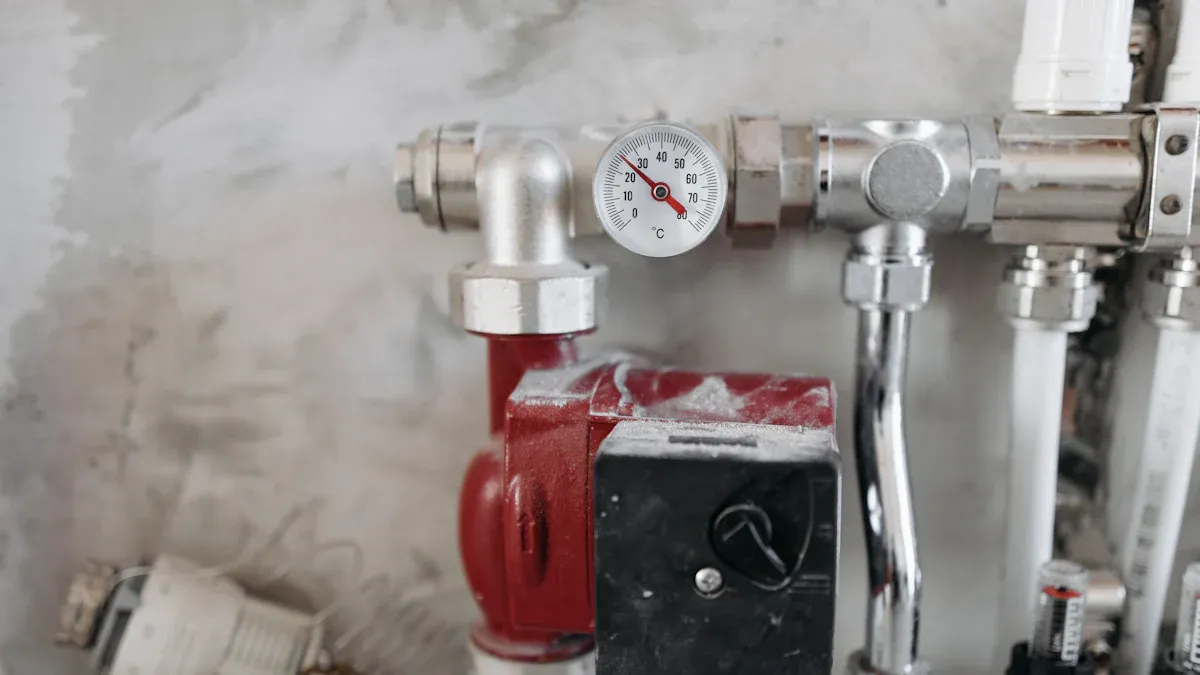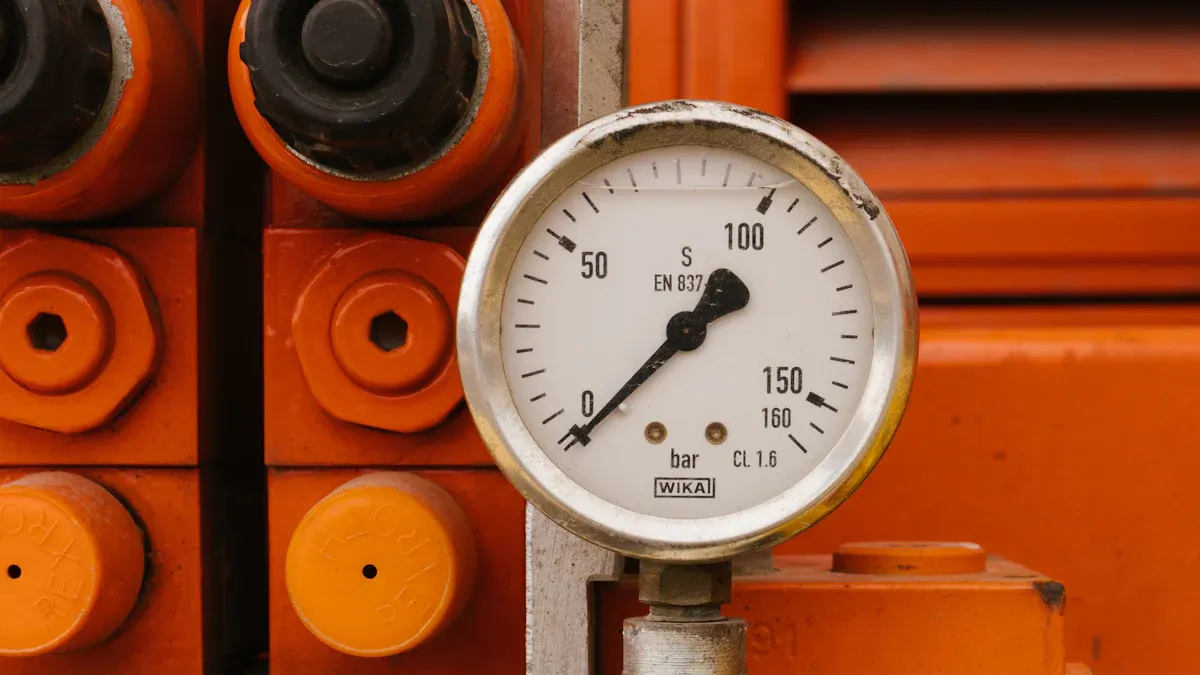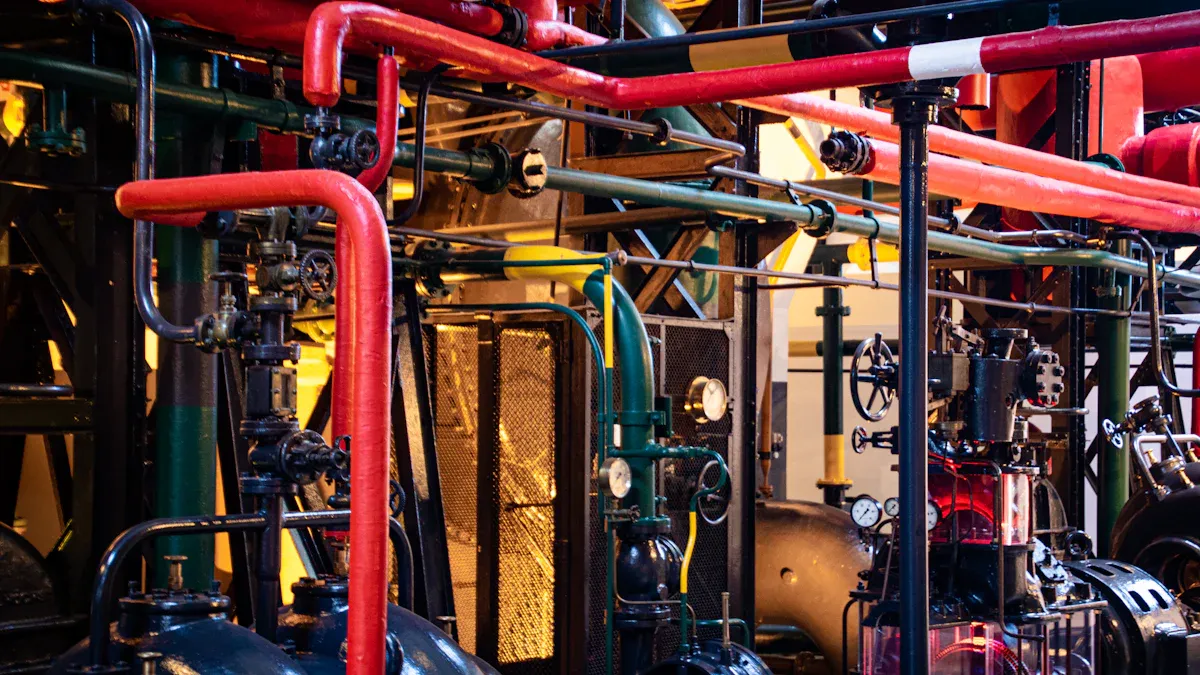
A hydraulic solenoid is an electromagnetic device that controls fluid flow in hydraulic systems. You can think of it as the “switch” that directs fluid movement. This device plays a key role in automating processes, ensuring precise control over operations in machinery, vehicles, and equipment.
Key Takeaways
- Hydraulic solenoids manage fluid flow in systems, working like a switch. Knowing how they work helps machines run smoothly.
- Taking care of solenoids, like checking seals and coils, stops problems. This makes them last longer and work better.
- Solenoids help machines in many industries work automatically. They make things more accurate, save energy, and need less human effort.
What is a Hydraulic Solenoid?
Definition and basic concept
A hydraulic solenoid is an electromagnetic device that acts as a control mechanism in hydraulic systems. It converts electrical energy into mechanical motion, allowing you to manage the flow of hydraulic fluid with precision. At its core, the solenoid consists of a coil of wire that generates a magnetic field when electricity passes through it. This magnetic field moves a metal plunger or armature, which then interacts with a hydraulic valve to open or close it.
Think of it as a bridge between electrical signals and mechanical actions. When you activate the solenoid, it responds instantly, enabling or restricting fluid flow. This makes it an essential component in systems where quick and accurate control is necessary. Without hydraulic solenoids, many automated processes in machinery and equipment would be far less efficient.
Tip: If you’re new to hydraulic solenoids, start by understanding how electricity and magnetism work together. This will help you grasp the basic principles behind their operation.
Role in hydraulic systems
In hydraulic systems, the hydraulic solenoid serves as a key player in controlling fluid movement. It works in tandem with hydraulic valves to regulate pressure, direction, and flow rate. By doing so, it ensures that the system operates smoothly and efficiently. For example, when you need to lift a heavy load with a hydraulic crane, the solenoid activates the valve that directs fluid to the appropriate cylinder.
Hydraulic solenoids also enable automation in complex systems. They allow you to control multiple operations simultaneously without manual intervention. This is particularly useful in industries like manufacturing, where precision and speed are critical. Additionally, they help reduce energy waste by ensuring that fluid flows only when needed.
Note: Regular maintenance of hydraulic solenoids can prevent system failures and extend their lifespan. Always check for signs of wear or damage.
How Hydraulic Solenoids Work

Electromagnetic operation
The operation of a hydraulic solenoid begins with the principles of electromagnetism. When you send an electrical current through the solenoid’s coil, it generates a magnetic field. This magnetic field pulls a metal plunger or armature inside the solenoid. The movement of this plunger is what creates the mechanical action needed to control the hydraulic system.
Imagine flipping a light switch. The electricity flows instantly, and the bulb lights up. Similarly, when you activate the solenoid, the magnetic field forms immediately, causing the plunger to move. This movement either opens or closes a hydraulic valve, allowing fluid to flow or stopping it. The speed and precision of this process make hydraulic solenoids ideal for systems that require quick responses.
Did you know? The strength of the magnetic field depends on the number of wire coils and the amount of current passing through them. A stronger field results in more forceful plunger movement.
Interaction with hydraulic valves
The hydraulic solenoid works closely with hydraulic valves to control fluid flow. When the solenoid’s plunger moves, it directly interacts with the valve mechanism. For example, in a spool valve, the plunger might push or pull the spool to change the direction of the fluid. This interaction determines whether the fluid flows to a specific cylinder, motor, or other components in the system.
You can think of the solenoid as the “brain” and the valve as the “muscle.” The solenoid sends the signal, and the valve performs the action. This teamwork ensures that hydraulic systems operate smoothly and efficiently. For instance, in a forklift, the solenoid and valve work together to lift or lower the forks by directing fluid to the appropriate hydraulic cylinder.
Pro Tip: To ensure optimal performance, always check the alignment between the solenoid and the valve. Misalignment can lead to inefficient fluid control or system failure.
Components of a Hydraulic Solenoid

Understanding the key components of a hydraulic solenoid helps you grasp how it functions. Each part plays a specific role in ensuring smooth operation and precise control.
Solenoid coil
The solenoid coil is the heart of the hydraulic solenoid. It consists of tightly wound copper wire that generates a magnetic field when electricity flows through it. This magnetic field powers the movement of the plunger. The coil’s design ensures efficient energy conversion, making it a critical component. You can often find the coil encased in protective material to prevent damage from heat or moisture.
Tip: Always check the coil’s insulation for wear. Damaged insulation can lead to short circuits or reduced performance.
Armature and plunger
The armature and plunger work together to create mechanical motion. When the coil generates a magnetic field, the plunger moves inside the solenoid housing. This movement interacts with the hydraulic valve to control fluid flow. The armature, often made of ferromagnetic material, enhances the magnetic effect, ensuring reliable operation. You can think of this duo as the “muscle” of the solenoid.
Housing and seals
The housing protects the internal components from external elements like dust, water, and heat. It also provides structural support. Seals within the housing prevent fluid leaks, ensuring the hydraulic system remains efficient. Durable materials like stainless steel or aluminum are commonly used for the housing. Proper sealing is essential for maintaining system pressure and avoiding contamination.
Note: Regularly inspect the seals for cracks or wear. Replacing damaged seals promptly can prevent costly repairs.
Applications of Hydraulic Solenoids
Industrial machinery
You’ll find hydraulic solenoids playing a vital role in industrial machinery. These devices control the movement of hydraulic actuators, ensuring precise operations in equipment like presses, conveyors, and robotic arms. For example, in a stamping press, the solenoid directs fluid to the cylinder, enabling the press to apply consistent force. This level of control improves efficiency and reduces errors in manufacturing processes.
Hydraulic solenoids also enhance safety. By automating fluid control, they minimize the need for manual intervention, reducing the risk of accidents. Regular maintenance of these solenoids ensures uninterrupted operation, which is critical in high-demand environments.
Automotive systems
In automotive systems, hydraulic solenoids contribute to smoother and more efficient vehicle performance. You’ll see them in automatic transmissions, where they regulate fluid flow to shift gears seamlessly. They also play a role in anti-lock braking systems (ABS), controlling hydraulic pressure to prevent wheel lockup during sudden stops.
These solenoids help vehicles achieve better fuel efficiency by optimizing hydraulic operations. Their compact design makes them ideal for modern cars, where space is often limited. Understanding their function can give you insights into how vehicles maintain precision and safety on the road.
Agricultural equipment
Hydraulic solenoids are indispensable in agricultural equipment. They control the movement of hydraulic arms, plows, and sprayers, making farming tasks more efficient. For instance, in a tractor, the solenoid directs fluid to lift or lower attachments like a harrow or a seed drill.
By automating these processes, hydraulic solenoids save time and reduce physical labor. They also ensure consistent performance, which is crucial for tasks like irrigation or planting. With proper care, these solenoids can withstand harsh outdoor conditions, providing reliable service for years.
Benefits of Hydraulic Solenoids
Precision in fluid control
Hydraulic solenoids give you unmatched precision when controlling fluid flow. They respond instantly to electrical signals, allowing you to regulate pressure, direction, and flow rate with accuracy. This precision ensures that hydraulic systems perform tasks exactly as intended. For example, in industrial machinery, solenoids help maintain consistent force during operations like stamping or cutting. You can rely on them to deliver repeatable results, which is essential for processes requiring high accuracy.
Tip: If you want to improve system precision, ensure the solenoid and valve are properly aligned. Misalignment can reduce control accuracy.
Energy efficiency
Hydraulic solenoids help you save energy by optimizing fluid flow. They only activate when needed, reducing unnecessary energy consumption. This feature makes them ideal for systems that operate intermittently or require variable control. For instance, in automotive systems, solenoids regulate hydraulic pressure efficiently, contributing to better fuel economy. By using solenoids, you can lower operational costs while minimizing environmental impact.
Did you know? Energy-efficient solenoids can extend the lifespan of hydraulic systems by reducing wear and tear on components.
Versatility in applications
You’ll find hydraulic solenoids in a wide range of applications, from industrial machinery to agricultural equipment. Their compact design and reliable performance make them suitable for diverse environments. In farming, solenoids automate tasks like lifting plows or controlling sprayers. In manufacturing, they enable precise movements in robotic arms and conveyors. Their adaptability allows you to use them in systems requiring quick responses and consistent performance.
Note: Regular maintenance ensures solenoids remain versatile and reliable across different applications.
Beginner Tips for Hydraulic Solenoids
Learn hydraulic system basics
Understanding hydraulic systems is the first step to mastering hydraulic solenoids. These systems use fluid to transfer power, and solenoids play a key role in controlling this flow. Start by learning the basic components, such as pumps, valves, cylinders, and reservoirs. Focus on how fluid moves through the system and how pressure affects its operation.
Tip: Watch simple animations or videos that explain hydraulic systems. Visual aids make it easier to grasp how solenoids fit into the bigger picture.
You can also explore beginner-friendly books or online tutorials. These resources often break down complex concepts into easy-to-understand explanations. By building a strong foundation, you’ll find it easier to understand how solenoids interact with other parts of the system.
Study solenoid diagrams
Diagrams are essential tools for understanding hydraulic solenoids. They show how solenoids connect to valves and other components. Start by identifying the solenoid coil, plunger, and housing in the diagram. Pay attention to the flow paths and how the solenoid controls fluid movement.
Did you know? Many manufacturers provide detailed diagrams in their product manuals. These diagrams can help you understand specific solenoid models.
Practice tracing the flow of electricity and fluid in the diagram. This exercise will improve your ability to read and interpret hydraulic schematics. Over time, you’ll develop the skills to troubleshoot and optimize solenoid performance.
Practice identifying components
Hands-on practice is the best way to learn. Begin by examining a hydraulic solenoid in person. Look for the coil, armature, plunger, housing, and seals. Understanding these parts will help you see how they work together.
Create a checklist to identify each component and its function. For example:
- Coil: Generates the magnetic field.
- Plunger: Moves to control the valve.
- Housing: Protects internal parts.
Note: If you don’t have access to a solenoid, use online images or 3D models. These tools can give you a close-up view of the components.
By practicing regularly, you’ll build confidence in identifying and understanding hydraulic solenoids.
Hydraulic solenoids are essential for modern systems, offering precision, efficiency, and versatility. They simplify complex operations and improve automation across industries.
Tip: Dive into hands-on practice and explore diagrams or tutorials. These resources will deepen your understanding and help you master hydraulic solenoids step by step.
Stay curious and keep learning!
FAQ
What are the common signs of a failing hydraulic solenoid?
- Delayed response in fluid control
- Unusual noises during operation
- Leaks around the housing
Tip: Regular inspections can help you catch these issues early.
Can you replace a hydraulic solenoid yourself?
Yes, you can replace it if you follow the manufacturer’s guide. Ensure the system is depressurized and powered off before starting.
Note: Seek professional help if unsure.
How do you maintain a hydraulic solenoid?
- Clean the housing regularly.
- Inspect seals for wear.
- Check the coil for overheating.
Did you know? Proper maintenance extends the solenoid’s lifespan significantly.
Post time: Jun-06-2025
